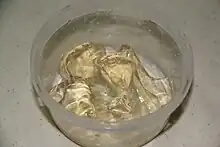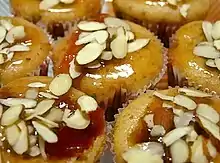Nappage
Nappage, jam glaze, pectin glaze or apricot glaze is a glazing technique used in pastry making. Nappage is a French word, meaning 'coating' or 'topping', and deriving from the word napper, meaning "to cover something with sauce". The glaze is used to cover fruit on a fruit tart or other baked goods, to make the fruit pieces shiny, prevent them from drying out, and to reduce oxidation.[1]



The active ingredient that gives nappage its glazing properties is pectin, a gelling agent naturally occurring in fruits.[2] Traditionally, a nappage is made using an apricot jam diluted with water to form a transparent, slightly apricot-colored glaze, though redcurrant jelly may be used instead to accentuate the colour of red fruits.[3] A neutral nappage (without the apricot flavour) may be made by mixing pure pectin with water and citric acid (or lemon juice) and heating to 45°C, which precipitates the gelling reaction, creating a base to which a diversity of flavours or colouring agents may be added. [2] Pectin NH (a variety of low methoxyl pectin) is typically used due to its thermoreversibility, which means that glazes made using it may be set and re-melted multiple times -- this is useful in a commercial context where nappage may be made in large batches. [4]
Nappage is typically applied to finished pastries using a pastry brush, dabbing rather than brushing to ensure an even coat. It is applied cool to cold fruits, otherwise it may be applied while still warm, thickening into a gel layer as it cools. [3]
References
- Laura Halpin Rinsky; Glenn Rinsky (2009). The Pastry Chef's Companion: A Comprehensive Resource Guide for the Baking and Pastry Professional. Chichester: John Wiley & Sons. pp. 12, 189. ISBN 978-0-470-00955-0. OCLC 173182689.
{{cite book}}: CS1 maint: multiple names: authors list (link) - "Neutral Nappage Glaze for Fruit Tarts". Chef Iso. Retrieved 3 August 2022.
- "Make a jam glaze". Leiths Cookery School. Retrieved 3 August 2022.
- "The Secret of NH Pectin". blog.modernistpantry.com. Kitchen Alchemy. Retrieved 3 August 2022.